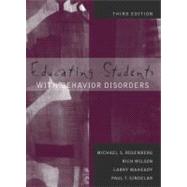
Each chapter contains “Summary,” “Discussion Questions,” and “References.”
1. Defining Behavior Disorders.
Definition.
An Alternative Approach.
Prevalence of Behavior Disorders.
2. High-Incidence Behavior Disorders.
Characteristics of Hyperactive Behavior.
Prevalence of Hyperactive Behavior.
Etiology of Hyperactive Behavior.
Course, Prognosis, and Outcome of Hyperactive Behavior.
Characteristics of Aggressive Behavior.
Prevalence of Aggressive Behavior.
Etiology of Aggressive Behavior.
Prognosis of Aggressive Behavior.
Rule Breaking and Juvenile Delinquency.
Prevalence of Rule Breaking and Juvenile Delinquency.
Correlates of Rule Breaking and Delinquency.
Etiology of Rule Breaking and Juvenile Delinquency
Prognosis of Rule Breaking and Juvenile Delinquency
Characteristics of Social Withdrawal.
Prevalence of Social Withdrawal.
Identification of Social Withdrawal.
Etiology of Social Withdrawal.
Prognosis of Social Withdrawal.
3. Low-Incidence Behavior Disorders.
Early Perspectives on Severe Behavior Problems of Childhood and Youth.
Pervasive Developmental Disorders.
Autistic Disorder.
Asperger's Disorder.
Childhood Degenerative Disorder.
Pervasive Developmental Disorder Not Otherwise Specified.
Early-Onset Schizophrenia.
4. Standardized Instruments of Assessment and Classification.
Purposes of Assessment.
Identification and Classification of Disordered Behavior.
Procedures of Identifying and Classifying Disordered Behavior.
Screening Methods.
Methods of Identification.
Interpreting Assessment Outcomes.
Technical Adequacy.
Assumptions Underlying Psychoeducational Assessment.
5. Direct and Functional Assessment of Behavior.
The Purposes and Direct and Functional Assessment of Behavior.
Conducting Functional Behavior Assessments.
Linking Functional Assessments to IEPs
6. Developing Individual Education Programs for Students with
Behavior Disorders
Legally Mandated IEP Requirements.
IEPs for Students with Behavior Disorders.
Involving Parents in the IEP Process.
7. Managing Hyperactive Behavior
Biophysical Interventions.
Dietary and Nutritional Approaches.
Behavioral Interventions.
Cognitive-Behavior Modification.
Other Therapies for Hyperactivity.
8. Managing Aggressive Behavior.
Psychodynamic Interventions.
Behavioral Interventions.
Other Treatments for Aggressive Behavior.
9. Managing Socially Withdrawn Behavior.
The Nature of Social Withdrawal.
Intervention Options.
Student-Managed Interventions.
General Guidelines for Selecting Intervention Strategies.
10. Managing Rule Breaking and Delinquency.
Major Approaches to Managing Rule Breaking and Delinquency.
Intervention Strategies for Specific Rule Breaking Behaviors.
Large-Scale Programs to Manage and Remediate Rule Breaking and
Delinquency.
Alternatives to Suspension
11. Teaching Students with Mild and Moderate Behavior Disorders.
Effective Teaching.
Organizing for Successful Instruction.
Delivering Instructional Content.
12. Developing Comprehensive Behavior Management Programs
Extent and Scope of School-wide Discipline Problems
Models of School-Wide Discipline
Common Elements in Effective School-Wide Discipline Programs
Processes Used in Developing Enduring Programs
13. Educating Students with Behavior Disorders: Prevailing Issues and Future Challenges.
Prevailing Issues and Future Challenges.
A National Agenda for Achieving Better Results.
Service Delivery Alternatives.
Assessment Practices with Culturally Diverse Students.
Addressing the Needs of Drug- and Alcohol-Exposed Children.
Transition to Postsecondary Alternatives.
Concern for Self: Reducing Stress and Burnout.
The Maturation of the Profession.
The New copy of this book will include any supplemental materials advertised. Please check the title of the book to determine if it should include any access cards, study guides, lab manuals, CDs, etc.
The Used, Rental and eBook copies of this book are not guaranteed to include any supplemental materials. Typically, only the book itself is included. This is true even if the title states it includes any access cards, study guides, lab manuals, CDs, etc.